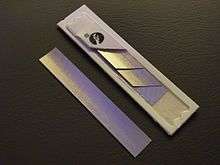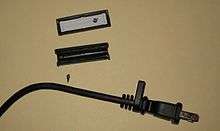Electronic article surveillance
Electronic article surveillance (EAS) is a technological method for preventing shoplifting from retail stores, pilferage of books from libraries or removal of properties from office buildings. Special tags are fixed to merchandise or books. These tags are removed or deactivated by the clerks when the item is properly bought or checked out. At the exits of the store, a detection system sounds an alarm or otherwise alerts the staff when it senses active tags. Some stores also have detection systems at the entrance to the restrooms that sound an alarm if someone tries to take unpaid merchandise with them into the restroom. For high-value goods that are to be manipulated by the patrons, wired alarm clips called spider wrap may be used instead of tags.
Types
There are several major types of electronic article surveillance systems:
- Magnetic, also known as magneto-harmonic
- Acousto-magnetic, also known as magnetostrictive
- Radio frequency
- Microwave
- Video surveillance systems (to some extent)
Magnetic systems

These tags are made of a strip of amorphous metal (metglas) which has a very low magnetic saturation value. Except for permanent tags, this strip is also lined with a strip of ferromagnetic material with a moderate coercive field (magnetic "hardness"). Detection is achieved by sensing harmonics and sum or difference signals generated by the non-linear magnetic response of the material under a mixture of low-frequency (in the 10 Hz to 1000 Hz range) magnetic fields.
When the ferromagnetic material is magnetized, it biases the amorphous metal strip into saturation, where it no longer produces harmonics. Deactivation of these tags is therefore done with magnetization. Activation requires demagnetization.
This system is suitable for items in libraries since the tags can be deactivated when items are borrowed and re-activated upon return. It is also suitable for low value goods in retail stores, due to the small size and very low cost of the tags (Tattle-Tape).
Acousto-magnetic systems

These are similar to magnetic tags in that they are made of two strips, a strip of magnetostrictive, ferromagnetic amorphous metal and a strip of a magnetically semi-hard metallic strip, which is used as a biasing magnet (to increase signal strength) and to allow deactivation. These strips are not bound together but free to oscillate mechanically.[1][2]
Amorphous metals are used in such systems due to their good magnetoelastic coupling, which implies that they can efficiently convert magnetic energy into mechanical vibrations.
The detectors for such tags emit periodic tonal bursts at about 58 kHz, the same as the resonance frequency of the amorphous strips.[3] This causes the strip to vibrate longitudinally by magnetostriction, and it continues to oscillate after the burst is over. The vibration causes a change in magnetization in the amorphous strip, which induces an AC voltage in the receiver antenna. If this signal meets the required parameters (correct frequency, repetition, etc.), the alarm is activated.
When the semi-hard magnet is magnetized, the tag is activated. The magnetized strip makes the amorphous strip respond much more strongly to the detectors, because the DC magnetic field given off by the strip offsets the magnetic anisotropy within the amorphous metal. The tag can also be deactivated by demagnetizing the strip, making the response small enough to that it will not be detected by the detectors.
These tags are thicker than magnetic tags and are thus seldom used for books. However, they are relatively inexpensive and have better detection rates (fewer false positives and false negatives) than magnetic tags.

Called Emtag by B&G International, this type tag is often attached to the inside of a plastic surround permanently attached to the power cords of hand tools and equipment.
Radio-frequency systems


These tags are essentially an LC tank circuit that has a resonance peak anywhere from 1.75 MHz to 9.5 MHz. The most popular frequency is 8.2 MHz. Sensing is achieved by sweeping around the resonant frequency and detecting the dip. Deactivation for 8.2 MHz label tags is achieved by punching a hole, or by detuning the circuit by partially destroying the capacitor. This is done by submitting the tag to a strong electromagnetic field at the resonant frequency, which induces voltages exceeding the capacitor's breakdown voltage.
Microwave systems
These permanent tags are made of a non-linear element (a diode) coupled to one microwave and one electrostatic antenna. At the exit, one antenna emits a low-frequency (about 100 kHz) field, and another one emits a microwave field. The tag acts as a mixer reemitting a combination of signals from both fields. This modulated signal triggers the alarm. These tags are permanent and somewhat costly. They are mostly used in clothing stores.
Source tagging
Source tagging is the application of EAS security tags at the source, the supplier or manufacturer, instead of at the retail side of the chain.[4] For the retailer, source tagging eliminates the labor expense needed to apply the EAS tags themselves, and reduces the time between receipt of merchandise and when the merchandise is ready for sale. For the supplier, the main benefit is the preservation of the retail packaging aesthetics by easing the application of security tags within product packaging. Source tagging allows the EAS tags to be concealed and more difficult to remove.
The high-speed application of EAS labels, suited for commercial packaging processes, was perfected via modifications to standard pressure-sensitive label applicators and was developed and introduced by Craig Patterson, initially for Hewlett Packard print cartridges. Today, consumer goods are source tagged at high speeds with the EAS label incorporated into the packaging or the product itself.
The most common source tags are AM strips and 8.2 MHz Radio Frequency Labels. Most manufacturers use both when source tagging. One significant problem from source tagging is something called "tag pollution" wherein non-deactivated tags carried around by customers cause unwanted alarms, decreasing the effectiveness and integrity of the EAS system.[5][6] The problem is that no store has both systems. Therefore if a store actually has an anti-shoplifting system to deactivate a label they will only deactivate one of the two. This is often the reason why people trigger an alarm entering a store, which can cause great frustration for both customers and staff. The problem is most evident in shopping malls where customers wander between stores. Retailers who use types of loss-prevention systems other than AM or 8.2 MHz Radio Frequency systems will not be as affected by "tag pollution".
Discussion
Occasional vs. informed shoplifters
EAS systems provide a good deterrent against casual theft. The occasional shoplifter, not being familiar with these systems and their mode of operation, will either get caught by them, or will refrain from stealing, but informed shoplifters can in many cases remove or deactivate tags. A very common way to defeat even active tags is construction of a foil-lined so-called booster bag into which active tagged items can be put, and will be shielded by the bag's conductive foil lining.
However, they may miss some tags or may be unable to remove or deactivate all of them, especially if concealed or embedded tags are used. (As a service to retailers, some manufacturers embed security tags in the packaging of their products, or even inside the product itself.) Ink-releasing tags known as benefit denial tags may reduce the rate of successful tag removal. Also, deactivating or detaching tags may be spotted by the shop staff.
Shoplifting tools are illegal in many jurisdictions, and can, in any case, serve as evidence against the perpetrators. Hence, informed shoplifters, although they decrease their risk of being caught by the EAS, expose themselves to much greater judicial risks if they get caught with tools, booster bags, or while trying to remove tags, as this characterizes intent to steal.
The possession of shoplifting tools (e.g. lined bags or wire cutters to cut bottle tags) can lead to the suspect being arrested for suspicion of theft or "Going equipped for stealing, etc." within the UK judicial system.[7]
In summary, while even the least expensive EAS systems will catch most occasional shoplifters, traditional surveillance measures are still required against informed ones.
Installation costs
A single EAS detector, suitable for a small shop, usually costs several thousand dollars or euros. Disposable tags cost a matter of cents and may have been embedded during manufacture. More sophisticated systems are available, which are more difficult to circumvent. These systems and tags are much more expensive, due to the use of more complex electronics and components.
Tag orientation
Except for microwave, the detection rate for all these tags depends on their orientation relative to the detection loops. For a pair of planar loops forming a Helmholtz coil, magnetic field lines will be approximately parallel in their center. Orienting the tag so that no magnetic flux from the coils crosses them will prevent detection, as the tag won't be coupled to the coils. This shortcoming, documented in the first EAS patents, can be solved by using multiple coils or by placing them in another arrangement such as a figure-of-eight. Sensitivity will still be orientation-dependent but detection will be possible at all orientations.
Detaching
A detacher is used to remove re-usable hard tags. The type of detacher used will depend on the type of tag. There are a variety of detachers available, with the majority using powerful magnets. Any store that uses an anti-shoplifting system and has a detacher should take care to keep it secured such that it cannot be removed. Some detachers actually have security tags inside them, to alert store personnel of them being removed from (or being brought into) the store.
Magnetic activation and deactivation
Deactivation of magnetic tags is achieved by straightforward magnetization using a strong magnet. Magneto-acoustic tags require demagnetization. However, sticking a powerful magnet on them will bias disposable magnetic tags and prevent resonance in magneto-acoustic tags. Similarly, sticking a piece of metal, such as a large coin on a disposable radio-frequency tag will shield it. Non-disposable tags require stronger magnets or pieces of metal to disable or shield since the strips are inside the casing and thus further away. Deactivation of some EAS tags can trigger signals sent to the shop clerk alerting them.
Shielding
Most systems can be circumvented by placing the tagged goods in a bag lined with aluminum foil. The booster bag will act as a Faraday cage, shielding the tags from the antennas. Although some vendors claim that their acousto-magnetic systems cannot be defeated by bags shielded with aluminum foil,[8] a sufficient amount of shielding (in the order of 30 layers of standard 20 µm foil) will defeat all standard systems.[9]
Although the amount of shielding required depends on the system, its sensitivity, the distance and orientation of the tags with relative to its antennas, total enclosure of tags is not strictly necessary. Indeed, some shoplifters use clothes lined with aluminum foil. Low-frequency magnetic systems will require more shielding than radio-frequency systems due to their use of near-field magnetic coupling. Magnetic shielding, with steel or mu-metal, would be more effective, but also cumbersome and expensive.
The shielding technique is well-known amongst shoplifters and store owners. Some countries have specific laws against it.[7][10] In any case, possession of such a bag demonstrates a prior-intent to commit a crime, which in many jurisdictions raises shoplifting from misdemeanor to felony status, as they are considered a "burglary tool." [11]
To deter the use of booster bags, some stores have add-on metal detector systems which sense metallic surfaces.
Jamming
Like most systems that rely on transmission of electromagnetic signals through a hostile medium, EAS sensors can be rendered inoperative by jamming. As the signals from tags are very low-power (their cross-section is small, and the exits are wide), jamming requires little power. Evidently, shoplifters will not feel the need to follow radio transmission regulations; hence crude, easy-to-build transmitters will be adequate for them. However, due to their high frequency of operation, building a jammer can be difficult for microwave circuits; these systems are therefore less likely to be jammed. Although jamming is easy to perform, it is also easy to detect. A simple firmware upgrade should be adequate for modern DSP-based EAS systems to detect jamming. Nevertheless, the vast majority of EAS systems do not currently detect jamming.
Interference and health issues
All electronic article surveillance systems emit electromagnetic energy and thus can interfere with electronics.
Magneto-harmonic systems need to bring the tags to magnetic saturation and thus create magnetic fields strong enough to be felt through a small magnet. They routinely interfere with CRT displays. Demagnetization-remagnetization units also create intense fields.
Acousto-magnetic systems use less power but their signals are pulsed in the 100 Hz range.
Radio-frequency systems tend to be the least interfering because of their lower power and operating frequency in the MHz range, which makes it easy to shield against.
A March 2007 study by the Mayo Clinic in Rochester, Minnesota reported instances where magnetic or acousto-magnetic EAS systems located at the front of retail stores caused a pacemaker to fail and a defibrillator to trigger, shocking the persons they were implanted in.[12]
There are also concerns that some installations are intentionally reconfigured to exceed the rated specifications of the manufacturer, thereby exceeding tested and certified magnetic field levels.
Patents
Radio-frequency systems have the most manufacturers because they are not covered by patents, use well-known technology derived from radio communications, use little power, and can be manufactured without expensive metal alloys. There are exceptions however for example; a patented die-cut circuit manufacturing process is held by Miyake Inc. of Japan. Also, patents have recently been appearing for various combination tag designs for integration of both RF and RFID. The last known patent is the "Global Guard" by Argos Global, an EAS system that integrates video surveillance hidden inside pedestals, getting a close up of the robbers.
Until recently, acousto-magnetic systems were covered by now-expired patents held by Sensormatic. WG Security Products, Inc. won a court battle against Sensormatic clarifying that WG Security Products acousto-magnetic systems did not infringe any Sensormatic patents.[13] Disposable acousto-magnetic tags require special metal alloys; non-disposable ones require more expensive ferrite cores.
See also
References
- ↑ Herzer, G., “Magnetic materials for electronic article surveillance”, Journal of Magnetism and Magnetic Materials, 254-255, p598-602, 2003.
- ↑ HowStuffWorks.com, “How Anti-shoplifting Devices Work”, http://electronics.howstuffworks.com/anti-shoplifting-device.htm
- ↑ Vitag Security
- ↑ Sensormatic, “Global Source Tagging”, http://www.sensormatic.com/Products/GST/GST_home.aspx
- ↑ VeriPak Products, Tag Pollution Survey Results, http://veripakproducts.com/Tag%20Pollution%20Survey%20Results.pdf
- ↑ Sensormatic, "Global Source Tagging / Glossary of Terms", http://www.sensormatic.com/Products/GST/glossary.aspx
- 1 2 Statute Law database, Theft Act (1968) (c. 60) s. 25(1), "Going equipped for stealing, etc.", http://www.statutelaw.gov.uk/content.aspx?LegType=All+P...1&activeTextDocId=2922479&linkToATDocumentId=1204274&linkToATVersionNumber=3&showProsp=1�
- ↑ Acousto-Magnetic Technology
- ↑ About booster bags
- ↑ The Independent, 14 June 1994, "Newsbrief: Shoplifting bag" http://www.independent.co.uk/life-style/newsbrief-shoplifting-bag-1422609.html
- ↑ Booster bag felony law example
- ↑ J. Rod Gimbel, MD, and James W. Cox, Jr, MD (March 2007). "Electronic Article Surveillance Systems and Interactions With Implantable Cardiac Devices: Risk of Adverse Interactions in Public and Commercial Spaces" (PDF). Mayo Clinic Proceedings. Retrieved 2007-04-22. Study referenced in news article "Cell phones safe to use in hospitals: U.S. study". Reuters. 2007-03-09. Retrieved 2007-04-22.
- ↑ Raymond, Nate (2008-03-01). "Taming Texas". The American Lawyer. American Lawyer Media. Retrieved 2008-09-04.
| Wikimedia Commons has media related to Electronic article surveillance. |